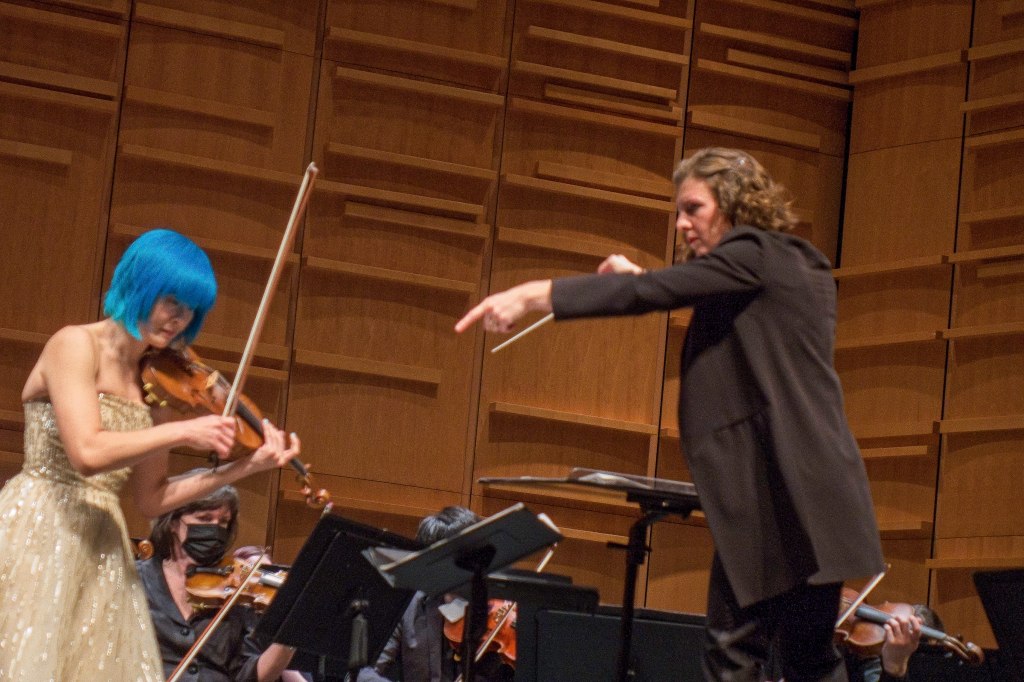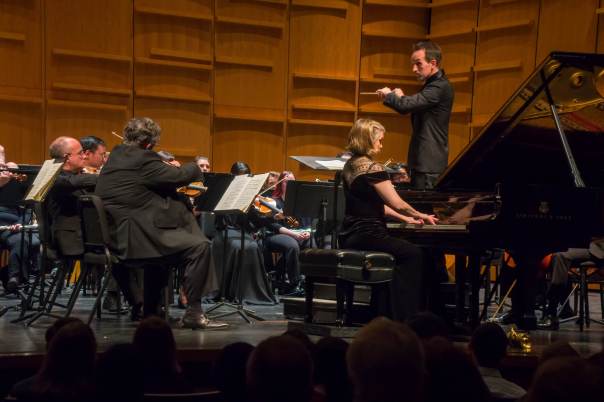Review: Charlotte Symphony Plays Wagner + Strauss
By Perry Tannenbaum

March 22, 2024, Charlotte, NC – Charlotte Symphony’s latest concert pairing, Wagner + Strauss, is logical and cohesive enough, but with the two Germans represented by the “Liebestod” (love-death) from Tristan and Isolde followed by the great Death and Transfiguration tone poem, abundant jollity seemed unlikely at Knight Theater. Wedged between these famed titans of 19th and 20th century music, however, were two lesser-knowns, Richard Strauss’s contemporary Oskar Böhme (1870-1938) and American composer Julia Perry (1924-1979). Thankfully, these composers, especially Oskar, lightened things up. Originally scheduled to perform with Symphony in August 2020, renowned conductor JoAnn Falletta returned for her first guest appearance with the orchestra since 2002, and principal trumpeter Alex Wilborn, similarly postponed by the pandemic, made his solo debut in Böhme’s Trumpet Concerto.
When former Symphony music director Christof Perick last performed the “Liebestod” at Belk Theater – almost precisely 15 years ago – he also paired the piece with a revered Strauss tone poem, Also Sprach Zarathustra. Strauss was one of Perick’s prime passions, and the Friday evening performance reaffirmed that the ardent Prelude and Liebestod remains deeply embedded in the ensemble’s DNA. Falletta’s reading, gradually peaking to a lovers’ climax, with delicious peeps at the hypnotic love theme that blossomed with promise, made me feel afterwards like asking if anybody else in the audience craved a cigarette.
Musically, it seems like a trumpet is a better post-coital sequel for Symphony than a cigarette when they finish the Liebestod, for who can contemplate Strauss’s Zarathustra without recalling its trumpet heraldry? Now that Wilborn is in the principal chair, he could bring us a virtuosic account of Böhme’s Trumpet Concerto with a surprise bonbon afterwards. The opening Allegro moderato brought forth a beautifully burnished tone from Wilborn’s horn and delectably supple phrasing, hardly seeming to challenge his technique, while Falletta emphasized the massiveness and lyricism of the orchestral accompaniment. That foundation segued nicely into the middle Adagio religioso movement, which began with stately dignity from the strings and brass and peaked with soaring aspiration from the soloist, no less pleasing than the melodic opening movement. It was only in the closing Rondo that we could savor anything close to Wilborn’s full virtuosity. Some real jollity here.

Perhaps both Wilborn and Falletta felt that the fireworks were all too brief in Böhme’s finale, for after the audience ovation, the trumpet virtuoso returned with perhaps the lengthiest encore ever heard at Knight Theater. Jean-Baptiste Arban’s “Variations on The Carnival of Venice” had all the virtuosic challenges and exploits you could ask for, with merciful orchestral interludes between the clusters of variations so that Wilborn could catch his breath. It wasn’t just speed that was demanded: in the most intense variations, we needed to make out the main melody amid a blizzard of relatively quiet filigree. The effect was sensational, exhilarating, and exhausting. Falletta showed us how much fun she was having long before she could rest her weary arms and face us again, and Wilborn, in a gesture that promised both him and his audience some respite, jokingly signaled to us when there were only three variations remaining.
Sadly, it would be an understatement to say that African American composer Julia Perry’s work has been neglected in her homeland. Only a handful of recordings – and no full-length CDs – exist from her voluminous output, which included 12 symphonies and four operas. The work unveiled in Charlotte, A Short Piece for Orchestra (1952), has only been recorded once, 14 years ago by the Imperial Philharmonic of Tokyo.

Falletta’s helter-skelter reading of the work made it feel far more modern and audacious than the more lyrical and legato Tokyo take under William Strickland’s baton. A live performance certainly brought out more textures after the raucous opening, including some dreamy reeds from principal clarinetist Taylor Marino and acting principal oboist Erica Cice. From the rear of the ensemble, a snare drum’s tattoo and some noodling from a celesta crept in. Really lovely stuff. My first exposure to Perry came just three days before her centennial birthday might be celebrated (apparently, there’s a half-billion-dollar bond deadline that’s considered to be a bigger deal).
The crisp dynamics that distinguished A Short Piece made a difference once again as Falletta turned to Tod und Verklärung. There was thunder like Perick brought to the work plus a little more electric crackle. In the more sweeping passages, the orchestral blend was as exquisite as ever, yet there were also ample opportunities for Cice, Marino, principal flutist Victor Wang, and concertmaster Calin Lupanu to shine in the hushed moments. Perick’s interpretation had more narrative cohesiveness and continental flavor, while Falletta’s took the piece in a more American direction, almost exiting the realm of a tone poem and crossing over into a concerto for orchestra. Opening up the dynamic range was certainly an intriguing and exciting approach. After waiting an extra four years, Falletta clearly triumphed in her return.












 Sitting toward the front of the orchestra, I found that the cameras consistently revealed who was playing upstage when the musicians in front of them blocked my sightline. My fears of being overwhelmed by the sheer loudness of the orchestra were also allayed: the acoustic shell that graces the Knight stage gathers in the orchestral sound while still allowing it to breathe. This was different from the old school presentation that the CSO brought us of the Fantasy-Overture at Belk Theater in 2011, and while there was little to prefer musically at either performance, I have to say that the camera work lifted the current experience above the one I praised five years ago, enriching what I saw and heard then with occasional close-ups of Warren-Green’s expressions.
Sitting toward the front of the orchestra, I found that the cameras consistently revealed who was playing upstage when the musicians in front of them blocked my sightline. My fears of being overwhelmed by the sheer loudness of the orchestra were also allayed: the acoustic shell that graces the Knight stage gathers in the orchestral sound while still allowing it to breathe. This was different from the old school presentation that the CSO brought us of the Fantasy-Overture at Belk Theater in 2011, and while there was little to prefer musically at either performance, I have to say that the camera work lifted the current experience above the one I praised five years ago, enriching what I saw and heard then with occasional close-ups of Warren-Green’s expressions. After Huddleston, Whittington seemed woefully mature as Juliette singing the bubbly “Je veux vivre” from Gounod’s opera. The costume she wore was comparatively formal and neither the suppleness of her coloratura nor the lightness of her tone matched what we hear from elite sopranos in this showpiece. But she returned later in the concert and absolutely scorched Juliette’s “Potion Aria,” demonstrating the power that opera can add to turbulent moments of indecision. Huddleston and Hajmahmoud do all the potions and suicides as well, but their most glorious moments – and Hartley’s as well – come when they do the balcony scene.
After Huddleston, Whittington seemed woefully mature as Juliette singing the bubbly “Je veux vivre” from Gounod’s opera. The costume she wore was comparatively formal and neither the suppleness of her coloratura nor the lightness of her tone matched what we hear from elite sopranos in this showpiece. But she returned later in the concert and absolutely scorched Juliette’s “Potion Aria,” demonstrating the power that opera can add to turbulent moments of indecision. Huddleston and Hajmahmoud do all the potions and suicides as well, but their most glorious moments – and Hartley’s as well – come when they do the balcony scene.